Comprehensive guide to understanding malware threats and robust techniques to keep your device secure
Learn how to protect your computer from malware and cyber attacks. Discover the best practices, tools, and tips to ensure the safety of your personal data and prevent cyber criminals from breaching your system.
Introduction
The digital era has revolutionized the way we live, work, and communicate, but it has also opened doors to numerous cyber threats. One of the most prevalent forms of these threats is malware. In this comprehensive guide, we will help you understand what malware is, how it functions, and how you can safeguard your computer from cyber attacks. Protecting your computer from malware is essential to secure your personal data and maintain system performance.
1. Understanding Malware
Malware, short for malicious software, is a broad term that includes various forms of harmful software designed to infiltrate, damage, or steal data from a computer system. These include viruses, worms, Trojans, ransomware, spyware, and adware, among others.
2. Importance of Malware Protection
Cyber attacks can result in financial losses, identity theft, and damage to a computer's hardware and software. It is crucial to protect your computer against malware, as it can help you:
- Secure your personal information
- Prevent unauthorized access to your accounts
- Maintain system performance and stability
3. Best Practices for Malware Protection
Here are some best practices to ensure the security of your computer against malware:
A. Keep Your Operating System and Software Updated
Regularly updating your operating system and software is crucial to protect your computer from malware. Software updates often include security patches that address vulnerabilities exploited by cyber criminals.
B. Use a Reliable Antivirus and Anti-Malware Software
Invest in a reputable antivirus and anti-malware software to regularly scan and remove malicious software from your computer. Make sure to update your security software regularly to ensure it can detect the latest threats.
C. Enable Firewall Protection
A firewall serves as a barrier between your computer and the internet, restricting unauthorized access to your system. Enabling your computer's built-in firewall or installing a third-party firewall software can significantly enhance your system's security.
D. Practice Safe Browsing Habits
Avoid visiting suspicious websites, clicking on unknown links, and downloading files from untrusted sources. Cyber criminals often use phishing techniques and malicious websites to infect your computer with malware.
E. Be Cautious with Email Attachments
Malware can spread through infected email attachments. Always verify the sender's identity before opening any attachments, and scan them with your antivirus software.
F. Regularly Backup Your Data
Regularly backing up your data can help you recover your files in case your computer is compromised by malware or ransomware attacks.
G. Secure Your Wi-Fi Network
Encrypt your Wi-Fi network by using a strong password and enabling WPA2 or WPA3 security protocols. This will prevent unauthorized access to your network and reduce the risk of malware infections.
4. Popular Malware Protection Tools
Here are some popular tools to protect your computer from malware:
- Norton AntiVirus Plus
- Bitdefender Antivirus Plus
- Malwarebytes Anti-Malware
- Kaspersky Anti-Virus
- McAfee Total Protection
- Avast Free Antivirus
- AVG AntiVirus Free
Conclusion
Malware protection is essential to safeguard your computer and personal data from cyber threats. By following the best practices outlined in this guide, you can significantly reduce the risk of malware infections and ensure a safe computing experience. Stay vigilant and proactive in securing your digital assets to stay

